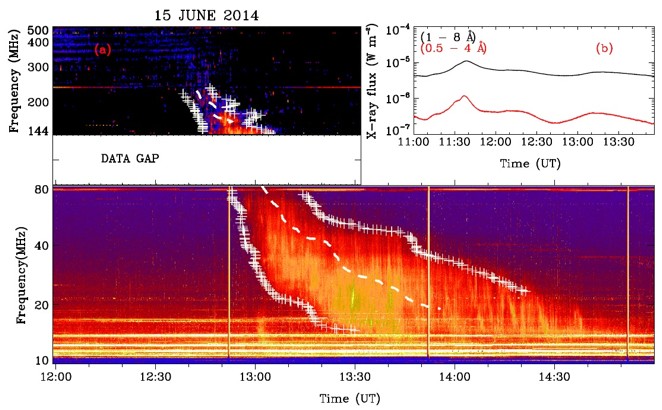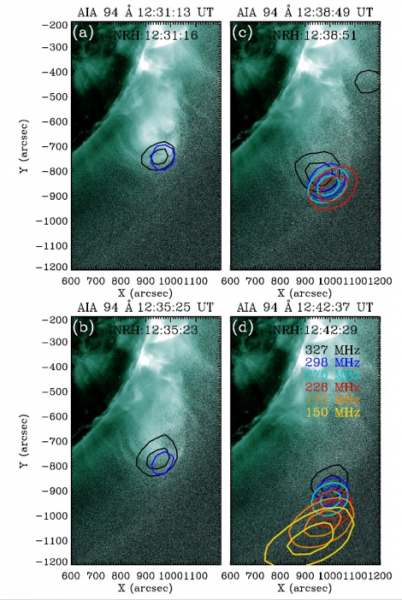T-IV solar radio bursts are wideband continuum observed with dynamic spectrographs at metric to decametric wavelengths. They can be classified into static and moving ones, according to whether the sources remain basically static or move outward. The static ones are related to solar flares with frequencies extending up to GHz, while the moving ones (T-IVms) are related to coronal mass ejections (CMEs) with frequencies sometimes shifting to tens of MHz.
Earlier studies, mainly based on the Culgoora radio-heliograph data, reveal various morphologies of T-IVm sources, in form of plasmoid, advancing front, or loop-like structure (e.g., Wild 1970). In addition, T-IVms were found to be closely associated with coronal transients, including eruptive prominence and flare surges, long before CMEs were discovered. Due to scarcity of simultaneous imaging data at different wavelengths, it remains elusive about which part of CMEs releases the radio bursts.
It is also controversial regarding what emission mechanism accounts for T-IVms. Both incoherent gyrosynchrotron emission and coherent plasma emission have been suggested. Earlier studies found that T-IV sources can be traced as far as 5 solar radii at 80 MHz, much higher than the corresponding plasma level. In addition, no dispersion of T-IV sources with observing frequencies was found in some studies on the basis of earlier interferometric data. These observations were considered to be against plasma emission, and in line with gyrosynchrotron from mildly relativistic electrons.
Observations and data analysis
Here we investigate a T-IVm burst (Figure 1). It is a very clean event without interference from other bursts. The event is well observed by a tandem of instruments (NRH, AIA/SDO, LASCO/SOHO, EUVI/STEREO). The observations, together with the limb perspective, make the event a nice candidate for studies on T-IVms.

Figure 1. The composite of dynamic spectra of the T-IVm burst recorded by ORFEES (300-144 MHz, upper part) and NDA (80-10 MHz, lower part). A data gap exists between 144 MHz and 80 MHz. (b) The GOES SXR light curves.
In Figure 2, the T-IVm sources observed by NRH are overlaid onto corresponding images at 94 Å. Initially, the sources are well co-spatial with a gradually-rising and twisted EUV structure, observable only through hot channels like 94 and 131 Å, indicating the presence of high-temperature plasmas. Evidence of magnetic reconnection is observed with the formation of the structure. The reconnection may have generated energetic electrons that are then injected into and trapped by the eruptive structure.

Figure 2. T-IVm sources observed by NRH, superposed onto the AIA-94 Å images at closet times. NRH sources are represented by 85% and 95% contours of corresponding maxima of brightness temperature.
The hot EUV structure later develops into a CME as observed by LASCO-C2. In the AIA FOV, the T-IVm sources lie in the upper part of the EUV structure, and in the LASCO-C2 FOV, one source at 150 MHz is still observable by NRH, located at the upper part of the bright core of the CME. This suggests that the CME bright core, at least partially, originates from the hot EUV structure (usually, the CME bright core is attributed to dense eruptive filament).
We find that T-IVm sources line up together to form a section of an arcade-like structure (see Figure 2d), with clear spatial dispersion with frequencies. The burst lasts for at least 2.5h. In addition, its brightness temperature varies from 107 to 109 K, and the polarization levels remain weak in general. DEM analysis of AIA data shows that the electron density within the EUV structure is at the order of 108 cm-3 and the temperature is several MK.
These observations, especially the relatively high brightness temperature and the obvious spatial dispersion of sources with frequencies, do not support gyrosynchrotron to be the emission mechanism. Gyrosynchrotron simulations using density values given above with reasonable strength of magnetic field (e.g., 5 Gauss) reveal a similar conclusion. We therefore suggest that the T-IVm burst is given by plasma emission. One likely process to excite such emission is through z-mode maser driven by loss-cone distribution of energetic electrons trapped by the source structure. The instability shall grow in the parameter regime of ωpe>>ωce within a hot plasma background (~ several MK).
Conclusions
We found that T-IVm sources in the inner corona correlate with the upper part of a hot and twisted eruptive EUV structure, while in the outer corona the sources are associated with the top front of the bright core of a white light CME, indicating the CME core stems from the hot EUV structure. We also found that the T-IVm sources manifest a clear spatial dispersion with frequencies, with brightness temperature varying form 107-109 K and polarization level being in-general weak. Multi-wavelength data of AIA are used to infer plasma properties of T-IVm sources, such as density and temperature. Our observations support that the radiation mechanism of T-IVms is likely the coherent plasma emission excited by energetic electrons trapped within the source structure.
Based on a recently published article: V. Vasanth, Yao Chen, Maoshui Lv, Hao Ning, Chuangyang Li, Shiwei Feng, Zhao Wu, and Guohui Du (2019), Source Imaging of a Moving Type IV Solar Radio Burst and Its Role in Tracking Coronal Mass Ejection from the Inner to the Outer Corona, The Astrophysical Journal, 870:30 (11pp), https://doi.org/10.3847/1538-4357/aaeffd.
References
Wild, J. P. 1970, Proc. Astr. Soc. Australia, 1, 365
*Full list of authors: V. Vasanth, Yao Chen, Maoshui Lv, Hao Ning, Chuangyang Li, Shiwei Feng, Zhao Wu, and Guohui Du
